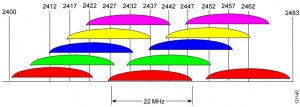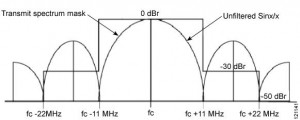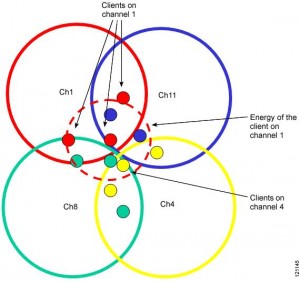802.11 2.4Ghz Nonoverlapping Channels
This will apply mostly to indoor deployments since it really covers 802.11B/G deployments. The idea here is that you only have so much spectrum to work with and you don’t want to trample on in-use space.
In 2.4 you have a total of 3 nonoverlapping channels. Let me say that again…3 nonoverlapping channels. 2400Mhz – 2483Mhz is your available spectrum. 802.11B uses 22Mhz channels. So, that gives us 66Mhz just for the transmissions themselves with ~4 Mhz of seperation = 74Mhz total used.

Graphic source here.
The radio propagation across the channels isn’t as precise as 22Mhz…there will be some bleed over into adjacent channels, which is why there is a degree of separation.

Graphic source here.
So what does all this mean to us…aka, why do I care? You care because 802.11 traditionally uses carrier sense multiple access(CSMA). What this means is that your client and the AP listen before they send data…if the air is clear, it will send, if it is not, it will wait until it is. If you only have a handful of clients, this doesn’t tend to be a problem. If you have a decent density of users, then this can quickly be an issue. If you have a lot of clients that are running in overlapping channels, then each will hear the other transmitting and can decrease the overall throughput as well as increase the latency. This is no bueno. By separating channels to non overlapping we can cut down on the amount of congestion in the air. See the Cisco graphic below:

Graphic source here.
As you can see, ill placed clients can create interference for others. I highly recommend you check out the source Cisco article on the subject which can be found here. It contains a plethora of detail and even talks about how 802.11G is even worse in the spectrum…hehe.
I have no doubt that my wireless guys will find plenty of flawed logic and be more than happy to make me look a fool, so fire away my fine feathered friends.


One of the reasons GPS sync is a good thing in outdoor deployments.
@Justin
That’s mild…I was expecting a tongue lashing.
Nope I thought you were pretty spot on with it all.
@Justin
How disappointing…